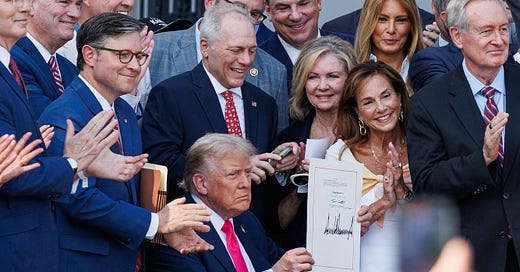A Tariff Time-Bomb
A critical part of the One Big Beautiful Bill’s budget equation may evaporate with a judicial pen stroke in the very near future. By Phillip W. Magness

President Donald Trump secured the first major legislative victory of his term with the adoption of the “One Big Beautiful Bill” Act, a multi-trillion-dollar spending package intended to codify his budgetary priorities. The measure contained a small victory for American taxpayers by forestalling the expiration of a 2018 income-tax cut this year. At the same time, fiscal hawks had much to criticise about the exorbitant new spending provisions, which are projected to accrue at least US$3 trillion in additional budget deficits over the next decade. The bill also contain a US$5 trillion increase in the national debt limit, removing a legislative constraint on government borrowing and setting the US national debt on track for an expansion to over US$41 trillion.
The One Big Beautiful Bill’s supporters portray the measure’s income tax cuts as a boon for economic growth, while its detractors worry about the profligate spending that is set to commence, including over US$160 billion in border and immigration enforcement funding along with the usual flurry of legislative pork. However, the One Big Beautiful Bill faces another obstacle on the horizon in the form of a ticking time bomb of tariffs. When preparing its budget calculations for the measure, Trump’s economic team relied on a new revenue source to offset its spending extravaganzas. The Council of Economic Advisors expects at least US$2.8 trillion in new tax receipts over the next decade from the tariffs the administration has been imposing on international trade with the rest of the world since the infamous “Liberation Day” press conference back in April.
Keep reading with a 7-day free trial
Subscribe to Quillette’s Substack to keep reading this post and get 7 days of free access to the full post archives.



